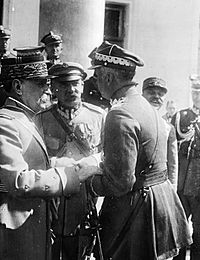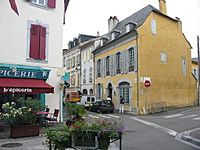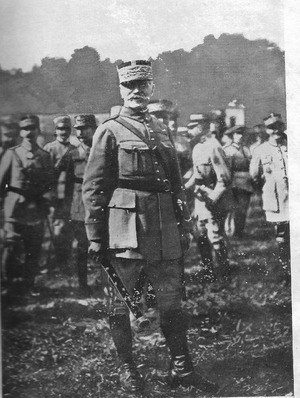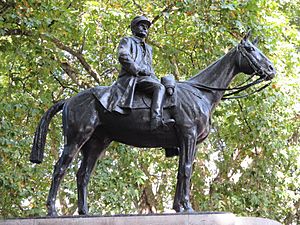Ferdinand Foch facts for kids
Quick facts for kids
Marshal
Ferdinand Foch
|
|
|---|---|

General Foch c. 1914
|
|
| Supreme Allied Commander | |
| In office 26 March 1918 – 10 January 1920 |
|
| Preceded by | Office established |
| Succeeded by | Office disestablished |
| 26th Chief of the Army Staff | |
| In office 16 May 1917 – 29 December 1918 |
|
| Preceded by | Philippe Pétain |
| Succeeded by | Henri Alby |
| Personal details | |
| Born | 2 October 1851 Tarbes, France |
| Died | 20 March 1929 (aged 77) Paris, France |
| Resting place | Les Invalides |
| Spouse | Julie Bienvenüe |
| Children |
|
| Parents |
|
| Alma mater | École Polytechnique |
| Signature |  |
| Military service | |
| Allegiance | |
| Branch/service | French Army |
| Years of service | 1868–1923 |
| Rank | Division general |
| Unit |
List
|
| Commands |
List
|
| Battles/wars | |
Ferdinand Foch (born October 2, 1851 – died March 20, 1929) was a famous French general. He became the top commander for the Allied forces during World War I. This means he was in charge of coordinating the armies of countries like France, Britain, and the United States.
Foch was known for being a very determined leader. He played a key role in stopping the German attacks in 1918. He then led a major counterattack that helped the Allies win the war. In November 1918, he officially accepted Germany's agreement to stop fighting.
Contents
Early Life and Military Training
Ferdinand Foch was born in Tarbes, a town in southwestern France. His family was very religious. He went to school in several different towns, including Metz. His brother became a priest, which was sometimes a challenge for Foch's career in the French Army because the government at the time was not very supportive of religious figures.
When he was 17, in 1870, Foch joined the French army. He stayed in the army even after the Franco-Prussian War ended. In 1871, he went to a famous engineering school called École Polytechnique. He chose to specialize in artillery, which means he learned about cannons and big guns.
In 1873, Foch became an artillery officer. He was promoted to captain in 1878. He also attended the École Supérieure de Guerre, a special war college, where he later taught from 1895 to 1901. He became a colonel in 1903.
Foch was a quiet person, but when he spoke, he was very direct and used a lot of hand gestures. He liked to be approachable to all officers. He was also known for his strong mind and always keeping a dignified manner.
In 1907, Foch was promoted to Brigadier General and became the head of the French War College. He held this important position until 1911. In 1913, he took command of the XX Corps in Nancy. He led this group into battle when World War I began in August 1914.
Foch's Military Ideas
Foch was considered a very original military thinker of his time. He carefully studied past wars, like the Franco-Prussian War and the Napoleonic Wars. He wanted to understand what lessons they held for modern warfare. He was one of the first to truly analyze France's defeat in 1870.
As a professor, Foch taught military history and strategy. He focused on offensive strategies, meaning attacking the enemy. He believed that "the will to conquer is the first condition of victory." His ideas helped to inspire a new generation of French officers.
His lectures were published in books like "On the Principles of War" (1903) and "On the Conduct of War" (1904). While Foch warned against reckless attacks, his ideas were sometimes misunderstood. Some military leaders took his offensive ideas to an extreme, which led to very costly battles for France in August 1914.
World War I: A Key Leader
1914: Stopping the German Advance
When World War I started in August 1914, Foch was leading the XX Corps. They were part of the French Second Army. His troops fought in the Battle of the Frontiers and suffered many losses. However, Foch managed to cover the French retreat and then launched a counter-attack that stopped the Germans.
Foch was then chosen to lead the new Ninth Army during the First Battle of the Marne. This was a very important battle. The French army was retreating, but Foch's forces fought hard to prevent a German breakthrough. He is famous for supposedly saying, "My center is yielding. My right is retreating. Situation excellent. I am attacking." While it's not clear if he actually sent this message, it shows his determined spirit.
Foch's counterattack worked, and the German advance was stopped. He received more troops and continued to push back. On September 12, Foch recaptured the city of Châlons. People saw him as a hero for helping to stabilize the Allied position.
After this, Foch became the Assistant Commander-in-Chief for the Northern Zone. His job was to coordinate the northern French armies and work with the British forces. This was crucial during the "Race to the Sea" where both sides tried to outflank each other. In October, the Germans attacked again at the First Battle of Ypres, but Foch again successfully coordinated a defense.
1915-1916: Challenges and Changes
In 1915, Foch was in command of the Northern Army Group. He led the Artois Offensive and, in 1916, the French efforts at the Battle of the Somme. These battles resulted in very heavy casualties for the Allied armies. Because of this, and some political disagreements, Foch was removed from his command in December 1916. He was sent to command Allied units on the Italian front.
1917: Return to Power
Just a few months later, after another French offensive failed, Foch was called back. He was promoted to chief of the general staff. Like other commanders, Foch believed that major attacks should be limited until the Americans, who had joined the war in April 1917, could send many more troops to France.
In November 1917, the Supreme War Council was created to coordinate the Western Front powers. Foch was appointed as a military representative. Many people already thought that Foch would eventually become the overall Allied Generalissimo, or Supreme Commander.
1918: Supreme Allied Commander
In March 1918, Germany launched a massive attack called the German spring offensive. This attack threatened to split the British and French forces. At a meeting on March 26, Foch was given the important job of coordinating all Allied armies. His task was to create a common reserve of troops and use them to protect the crucial area between the French and British armies.
Later, he was given the official title of Supreme Commander of the Allied Armies, or Généralissime. In May 1918, he was also given authority over the Italian Front. Foch also helped coordinate the supply systems for the American, British, French, Italian, and Belgian armies.
Foch was surprised by a German offensive in May, but the Allied armies under his command managed to stop the German forces. He was determined to keep the Allied armies together, even if it meant risking the loss of Paris. A British general noted that Foch's "fiery enthusiasm had been tempered by adversity," making him an even better leader.
On August 6, 1918, Foch was made a Marshal of France. Along with the British commander, Sir Douglas Haig, Foch planned the "Grand Offensive," which began on September 26, 1918. This major attack led to Germany's defeat.
On November 11, 1918, Foch accepted Germany's request for an armistice, which meant a stop to the fighting. He wanted peace terms that would prevent Germany from ever threatening France again. He believed the Treaty of Versailles, which officially ended the war, was too easy on Germany. He famously said, "This is not Peace. It is an Armistice for twenty years."
After the War

Foch received many honors after the war. He was made a British field marshal in 1919. For his advice during the Polish–Soviet War in 1920, he was also given the title of Marshal of Poland in 1923.
In 1921, Foch visited the United States to attend a ceremony for the Liberty Memorial in Kansas City, Missouri. He toured many American cities and received honorary degrees from universities.
Ferdinand Foch died on March 20, 1929. He was buried in Les Invalides in Paris, a famous building where many important French military figures are laid to rest.
A statue of Foch stands at the Compiègne Armistice site, where the 1918 armistice was signed. This statue was the only thing left untouched by the Germans when they defeated France in 1940 and destroyed the area around the railway car where the surrender took place.
Military Ranks Held
Foch rose through the ranks of the French Army:
- Private: January 24, 1871
- Student: November 1, 1871
- Artillery student: January 10, 1873
- Second lieutenant: October 16, 1874
- Lieutenant: October 1, 1875
- Captain: September 30, 1878
- Squadron chief: February 27, 1891
- Lieutenant colonel: July 10, 1898
- Colonel: July 12, 1903
- Brigadier general: June 20, 1907
- Divisional general: September 21, 1911
- Marshal of France: August 6, 1918
Honors and Awards
Foch received many honors from France and other Allied countries:
- Marshal of France: August 6, 1918
- Field Marshal of the United Kingdom: July 19, 1919
- Honorary Colonel of the Royal 22nd Regiment (Canadian Army): March 25, 1921
- Marshal of Poland: April 13, 1923
He also received many medals and decorations, including:
- Legion of Honour (France) – he earned all levels, from Knight to Grand Cross.
- Médaille militaire (France)
- Croix de Guerre 1914–1918 (France)
- Order of Merit (United Kingdom)
- Order of the Bath (United Kingdom)
- Distinguished Service Order (United Kingdom)
- Order of the White Eagle (Poland)
- Order of Virtuti Militari (Poland)
- Distinguished Service Medal (United States)
Many places and things have been named after him, including:
- A French heavy cruiser and an aircraft carrier.
- Streets and avenues in cities like Paris, Melbourne, Lyon, and Shanghai.
- A city quarter in Berlin called Cité Foch.
- Fochville in South Africa.
- A statue near Victoria railway station in London.
- Mount Foch in Alberta, Canada.
- A grape cultivar (type of grape).

See also
 In Spanish: Ferdinand Foch para niños
In Spanish: Ferdinand Foch para niños
- Jean de Lattre de Tassigny
- List of French paratrooper units
- Pierre Segretain
- Pierre Jeanpierre
- Marcel Bigeard
- 35th Parachute Artillery Regiment
- Moroccan Division
- Lafayette Escadrille
- Russian Expeditionary Force in France
- Marching Regiment of the Foreign Legion
- Army Manoeuvres of 1912
- Foch Line
- Marshal Foch Professor of French Literature, a chair at the University of Oxford established in Foch's honour in 1918
- Non-U.S. recipients of U.S. gallantry awards
- List of streets named after Ferdinand Foch






